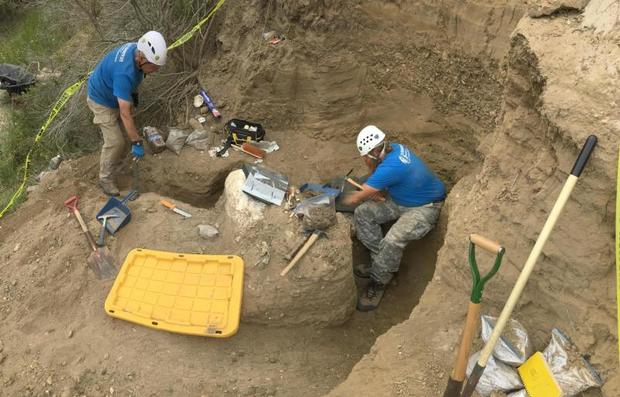Scientists Unearth Complete Mammoth Skull On Santa Rosa Island
VENTURA (CBSLA.com) — A rare, well-preserved fossil of a complete mammoth skull has been unearthed just off the coast of Southern California, National Park Service officials said Wednesday.
A team of archaeologists have dated charcoal samples found near the specimen on Channel Islands National Park's Santa Rosa Island to approximately 13,000 years – a significant time period because it coincides with the age of Arlington Man, the oldest human skeletal remains in North America, which were also found on Santa Rosa Island.
"This mammoth find is extremely rare and of high scientific importance. It appears to have been on the Channel Islands at the nearly same time as humans," paleontologist Justin Wilkins said in a statement. "I have seen a lot of mammoth skulls and this is one of the best preserved I have ever seen."
Researchers say the newly-discovered mammoth's tusks are particularly exciting, because the right tusk protrudes 1.4 meters in a coil characteristic of an older mammal, while the shorter, sloped left tusk is more typical of a juvenile.
Mammoths roamed North America approximately two million years ago, according to the National Park Service, but Columbian mammoths appeared about a million years later.
According to the team that found the skull, the size of the specimen is unusual because it is not large enough to be a Columbian mammoth or small enough to qualify as a pygmy mammoth. Scientists believe the Columbia mammoth migrated to the Channel Islands during the past two ice ages, when sea levels were lower and the Channel Islands were closer to the mainland coast.
Over time, the descendants of these mammoths downsized from approximately 14 feet to a six-feet-tall pygmy form, becoming a species known as Mammuthus exilis.
The mammoth specimen was first discovered in Sept. 2014 when a biologist conducting a stream study noticed an ivory tusk protruding from sediment in a canyon wall. The find has been informally named Larry, in recognition of the biologist who discovered the specimen, Peter Larramendy, and a colleague, the late Larry Agenbroad, one of the world's leading paleontologists.
Scientists say the specimen's teeth will allow them to age the skull within two years of death. The mammoth skull will ultimately be displayed at the Santa Barbara Museum of Natural History.




